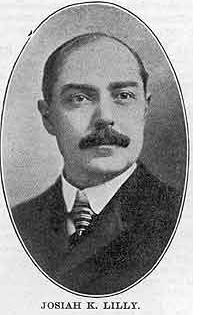Eli Lilly and Company
(Redirected from Lilly Research Laboratories)
American pharmaceutical company
Eli Lilly and Company is a global pharmaceutical company headquartered in Indianapolis, Indiana. Founded in 1876 by Colonel Eli Lilly, the company is known for its pioneering work in the development of insulin, psychiatric medications, and other significant pharmaceutical products.
History[edit | edit source]
Eli Lilly and Company was founded by Colonel Eli Lilly, a pharmaceutical chemist and veteran of the American Civil War. Lilly was committed to creating high-quality medicines that met rigorous standards of safety and efficacy. The company began with three employees and produced a range of pharmaceutical products, including capsules, pills, and fluid extracts.
In the early 20th century, the company expanded its operations and began to focus on research and development. This led to the introduction of several groundbreaking drugs, including insulin in the 1920s, which revolutionized the treatment of diabetes.
Innovations and Products[edit | edit source]
Eli Lilly and Company has been at the forefront of pharmaceutical innovation. The company was one of the first to mass-produce insulin and later developed penicillin during World War II. In the latter half of the 20th century, Lilly introduced several important psychiatric medications, including Prozac (fluoxetine), which became one of the most widely prescribed antidepressants in the world.
The company continues to focus on developing treatments for cancer, diabetes, autoimmune diseases, and neurodegenerative disorders.
Corporate Structure and Operations[edit | edit source]
Eli Lilly and Company operates in over 120 countries and employs tens of thousands of people worldwide. The company's headquarters are located in Indianapolis, Indiana, where it maintains a significant research and development presence.
The company is organized into several divisions, each focusing on different therapeutic areas. These include oncology, immunology, neuroscience, and endocrinology.
Research and Development[edit | edit source]
Research and development are central to Eli Lilly's mission. The company invests heavily in R&D to discover and develop new treatments. Lilly's research facilities are equipped with state-of-the-art technology and staffed by leading scientists in the field.
The company collaborates with academic institutions, research organizations, and other pharmaceutical companies to advance its research efforts.
Leadership[edit | edit source]
Leadership at Eli Lilly has been marked by a commitment to innovation and ethical business practices. The Lilly family played a significant role in the company's early years, with Josiah K. Lilly, Sr. and Josiah K. Lilly, Jr. both serving as presidents of the company.
Today, Eli Lilly is led by a team of experienced executives who continue to uphold the company's legacy of innovation and integrity.
Related pages[edit | edit source]
Search WikiMD
Ad.Tired of being Overweight? Try W8MD's physician weight loss program.
Semaglutide (Ozempic / Wegovy and Tirzepatide (Mounjaro / Zepbound) available.
Advertise on WikiMD
|
WikiMD's Wellness Encyclopedia |
| Let Food Be Thy Medicine Medicine Thy Food - Hippocrates |
Translate this page: - East Asian
中文,
日本,
한국어,
South Asian
हिन्दी,
தமிழ்,
తెలుగు,
Urdu,
ಕನ್ನಡ,
Southeast Asian
Indonesian,
Vietnamese,
Thai,
မြန်မာဘာသာ,
বাংলা
European
español,
Deutsch,
français,
Greek,
português do Brasil,
polski,
română,
русский,
Nederlands,
norsk,
svenska,
suomi,
Italian
Middle Eastern & African
عربى,
Turkish,
Persian,
Hebrew,
Afrikaans,
isiZulu,
Kiswahili,
Other
Bulgarian,
Hungarian,
Czech,
Swedish,
മലയാളം,
मराठी,
ਪੰਜਾਬੀ,
ગુજરાતી,
Portuguese,
Ukrainian
Medical Disclaimer: WikiMD is not a substitute for professional medical advice. The information on WikiMD is provided as an information resource only, may be incorrect, outdated or misleading, and is not to be used or relied on for any diagnostic or treatment purposes. Please consult your health care provider before making any healthcare decisions or for guidance about a specific medical condition. WikiMD expressly disclaims responsibility, and shall have no liability, for any damages, loss, injury, or liability whatsoever suffered as a result of your reliance on the information contained in this site. By visiting this site you agree to the foregoing terms and conditions, which may from time to time be changed or supplemented by WikiMD. If you do not agree to the foregoing terms and conditions, you should not enter or use this site. See full disclaimer.
Credits:Most images are courtesy of Wikimedia commons, and templates, categories Wikipedia, licensed under CC BY SA or similar.
Contributors: Prab R. Tumpati, MD



